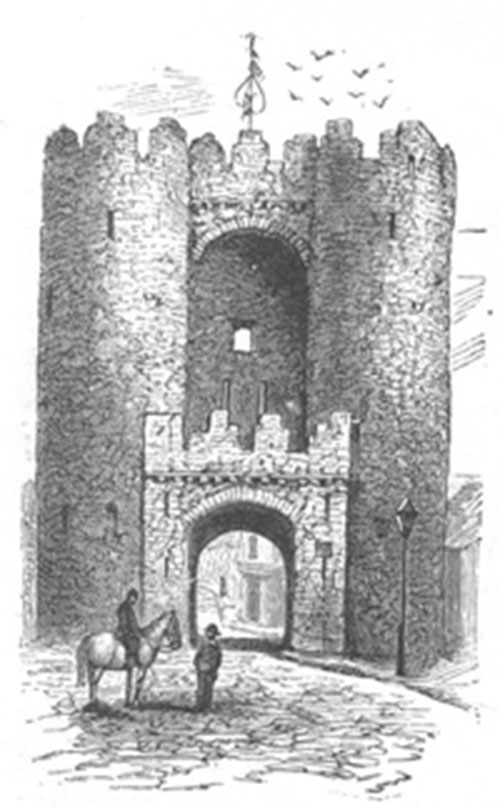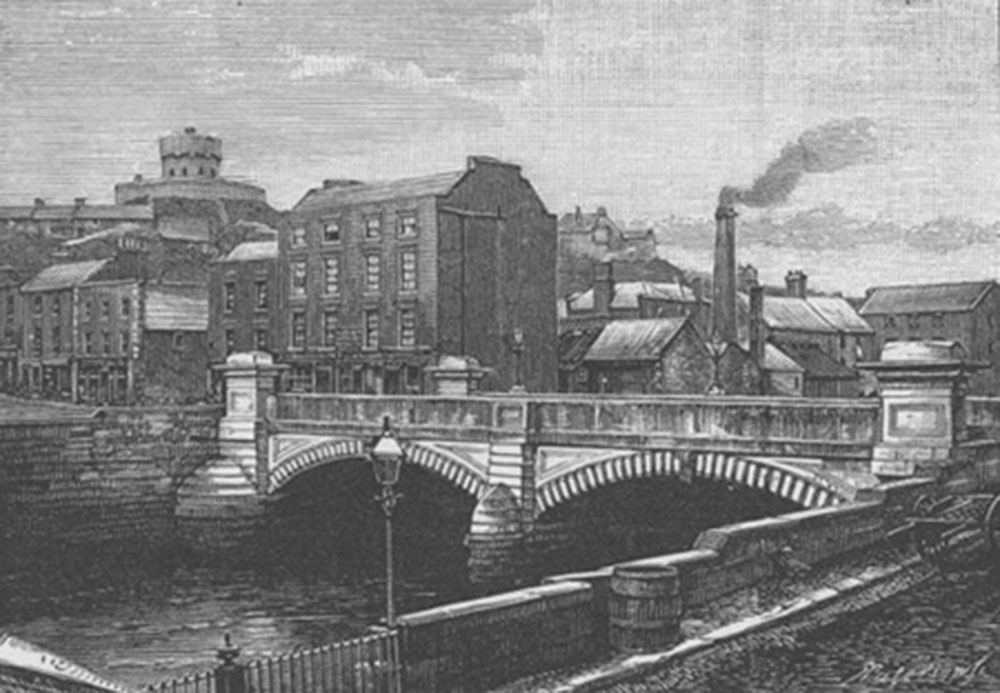Drogheda - Irish Pictures (1888)
From Irish Pictures Drawn with Pen and Pencil (1888) by Richard Lovett
Chapter III: The Valley of the Boyne … continued
« Previous Page | Start of Chapter | Book Contents | Next Page »
In glancing at this celebrated valley, we shall pass in review some of its most attractive sites, and recall a few of its most famous associations. Reversing the natural order of the river, we will ascend from the estuary towards the source. A great river like the Boyne, draining a rich agricultural country, necessarily possesses a port of the first rank. Drogheda (pronounced Draw-edd-a) is to-day one of the busiest towns in Ireland, and for many past centuries the pulses of a strong and active life have throbbed here. It is well situated on the steep banks of the Boyne, having many features in common with an ordinary continental town, and, when seen from a distance, it arouses the expectations of the traveller; but a closer inspection tends to modify first impressions, and adds another to the manifold evidences of the truth of that trite saying, 'distance lends enchantment to the view.'
From the earliest times Drogheda has figured more or less prominently in the history of Ireland. It was formerly a walled and strongly-fortified city, and although, unlike Derry, it has lost most of the ancient walls, some fine specimens yet remain. Chief among these is the St. Lawrence Gate, as perfect a specimen of that class of architecture as we could wish to see. As the wayfarer passes beneath the archway, and looks at the lofty towers, pierced by narrow windows and loopholes, imagination begins to picture the angry conflicts upon which it has looked down, and the successive generations that have passed in and out by its well-trodden entrance.
Drogheda stands by the site of an ancient ford. In process of time, as at Dublin and elsewhere, the fords were rendered needless by the construction of bridges. To the bridge built over the Boyne at this spot the town owes its name, Droichead-atha the Bridge of the Ford, from which the present name Drogheda is easily derived. The name indicates also that this was the first bridge built over the Boyne on the northern coast road. The quays along the river, crowded as they are by steamers and vessels of many kinds, give proof that the town is not only an important place on the northern road, but that by the waterways of the ocean she is in communication with distant parts of the earth.
It is believed by some that Milesius and his followers landed near the town, that in the struggle with the natives, his son Coalpha perished, the fact being commemorated in the name, Coelph, given to one of the parishes. It is more certain that Patrick passed by the ford on his way to Slane; that early in the tenth century it became a stronghold from which the Danes ravaged the surrounding country; that in 1395 Richard II. held an assembly in the church of Mary Magdalene, and that there four Irish chieftains did homage and fealty to the English monarch.
'Every one of them, before the words of submission, laid aside his cap, belt and skeyne, and kneeling down before the king, put both his hands joined between the king's hands, and repeated the words of fealty and submission in the Latin language.' In Henry VII.'s reign a parliament was held at Drogheda, in 1494, under the Lord Deputy, Edward Poynings, which passed the notorious 'Poynings Act,' by which it was decreed that the Irish Parliament should only deal with such matters as had already been approved by the Privy Council.
But the ever-memorable incident in Drogheda's history happened in 1649, when she attempted to withstand the greatest Englishman of the seventeenth century, who came to Ireland at the head of his veteran army, to bring the country back to the control of the British Parliament after its revolt and fearful massacres of the Protestants in 1641. Wide is the divergence of view as to what took place; not with regard to the facts—they are as clear as the sunlight—but as to the moral judgment to be passed upon them. In September, 1649, Oliver Cromwell summoned the garrison to surrender, 'To the which receiving no satisfactory answer,' his army stormed the town and put almost the whole garrison to the sword. Cromwell did not hesitate to give his view and justification of the deed.
'I am persuaded that this is a righteous judgment of God upon these barbarous wretches, who have imbued their hands with so much innocent blood; and that it will tend to prevent the effusion of blood in the future. Which are the satisfactory grounds to such actions, which otherwise cannot but work remorse and regret.' 'Such,' writes Carlyle, 'was the storm of Drogheda. A thing which, if one wanted good assurance as to the essential meaning of it, might well "work remorse and regret": for indisputably the outer body of it is emphatic enough! Cromwell, not in a light or loose manner, but in a very solemn and deep one, takes charge for himself at his own peril, that it is a judgment of God; and that it did save "much effusion of blood" we and all spectators can very readily testify .... In fact, it cut through the heart of the Irish War. Wexford storm followed (not by forethought, it would seem, but by chance of war) in the same stern fashion; and there was no other storm or slaughter needed in that country.'
The monuments of the past still existing in Drogheda are hardly so numerous as might be expected. There are the two ancient gate-towers, some traces of the old walls, the ruined church of St. Mary, and the fine tower of St. Mary Magdalene, the latter dating from the fourteenth century. Hence, most visitors prefer not to linger long in the town, and are eager to get out into the beautiful country, studded with sites and objects of interest, by which it is surrounded. Few excursions in Ireland can rival a day's wandering in the Boyne Valley, provided only that the sun be shining and the atmosphere clear enough to disclose the distant views.
« Previous Page | Start of Chapter | Book Contents | Next Page »


